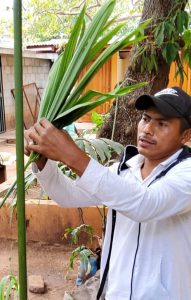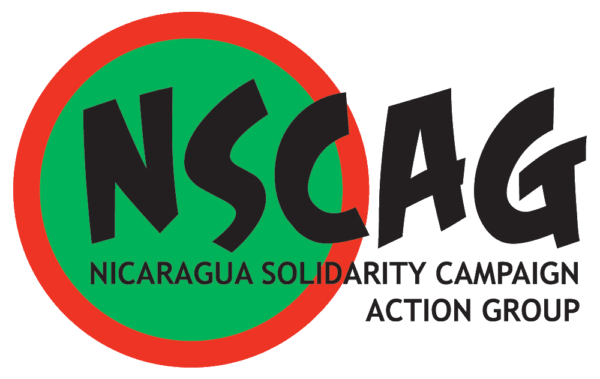Nicaragua Solidarity Campaign Action Group
20 January 2023
Weaving and selling the petate the co-operative way

The art of weaving using different plants is a fundamental part of Latin American history.
In Totogalpa, an Indigenous Chorotega municipality of Madriz, two co-operatives of young people and two adult cooperatives are involved in complementary ways in weaving and selling petate (woven mats and wall hangings).
Winnie Narváez Herrera and her colleagues from ÁBACOenRed / FUPEG, a teacher training initiative, visited the communities to find out more.
In Totogalpa they met Blanca, Flor, Estefania, Emilse, Jose Santos, Santos Natividad, Misael and Rolando who shared stories of their pride in indigenous crafts, the challenge of growing plant materials in a dry area impacted by the climate crisis, and what they have achieved through working in co-operatives.
Since 2008 the co-operatives have belonged to the Union of Co-operatives of Madriz (UNICOM R.L.), part of the national FECODESA federation since 2008.
Weaving is learned at home in the family and passed down through generations
This is how Misael described it: “I come from a family that has made a living from weaving because my grandmother, my aunt, and others make petates using palm leaves. My grandmother did this for nearly all of her 106 years, and she taught her daughters.”
Flor went on to explain: “There are quite a few of us who weave here. Anyone who is interested can just turn up and learn by observing.”
The work is carried out by both men and women. In some cases, women are in charge of weaving and men are in charge of selecting, cutting, and drying the raw materials. Others, such as José Santos or Emilse’s partner, also weave. Flor adds: “At home, I taught my partner to make bracelets then key rings. Now our daughter also makes jewellery boxes and bracelets.”
Other young people such as Emilse have opted to make crafts using pine cones.
Younger generations learn the art even though they do not always make a living from it. Some people work in other occupations, but others, even after going to university, continue to work in crafts and participate in fairs. Being part of an organisation that promotes art has helped them to make a living and avoid having to migrate. Misael describes life in the cooperative as very dynamic.



Co-operative members Estefania Rivera, Flor de Maria Lopez, and Jose Santos
Nature friendly crafts and the challenges of the climate crisis
The people in the two co-operatives make handicrafts from a variety of raw materials: bulrushes, pine cones, palm, clay and gourds.
Of all the materials, bulrushes are the ones that have undergone the greatest changes over time due to drought. They used to be plentiful along streams and ponds but now people often have to buy them from the owners of private property.
Estefanía explains: “The bullrushes used to have no owner. They grew in any stream but now they are scarce and thin and the co-op members buy them already dried.”
Palms take 15 years to grow between 1 and 1.5 meters tall. They are cut and then dried for eight days until the leaves go brown.
Some people buy the pine cones but in Emilse’s case there are pine trees in her community so she goes out to select them.
Flor goes on to explain that ‘no part of the materials is wasted: what is left over from making mats is used to make brooms and what is left over from brooms is used to tie nacatamales’ (a typical food made from maize and meat wrapped in plantain leaves).
Making and selling crafts generates incomes for local people
Working in handicraft has gained momentum as part of responding to the search for new economic activities. Misael explained: “In the face of climate change, droughts for example, we had to look for alternatives [to planting maize] to improve our socioeconomic situation. Crafts are an alternative that really get us involved as a family because we, as young people, can put into practice what we have learnt from previous generations.”
Diversifying sources of income
However, making and selling handicraft is not the only economic activity. The FECODESA Federation of Cooperatives, together with other institutions, has carried out participatory accompaniment of the communities researching and improving agroecological production using drought-resistant seeds.
Blanca explains that the ‘best alternative has been millet that needs less water than maize and is used as animal feed. But a lot of time and learning is needed to improve the quality so that it can be used for human consumption.’
Blanca describes how seeds are selected: “The producer identifies certain seeds among thousands, saying ‘that’s the one I like.’ For example, this seed has good yield; this one has x,y and z characteristics. The producer is the one who lives their own reality. S/he says: ‘No, that one is no good because you can’t make tortillas with it.’ The one who selects the seeds does so also on the basis of their soil and climate.”
The solidarity economy based on co-operatives represents a process of justice
Those of us who do not produce art are mere consumers but this also implies a responsibility: to know where the products we buy come from and understand what makes it possible.
Even at the local level there are prejudices that prevent us from recognising that craftwork is an actual job. This is what Flor shared with us: “When I was walking in town with my roll of mats trying to make a sale some guys made fun of me; I felt as if they were breaking my heart but I tried not to pay attention to them.”
The more distant a reality becomes, the more unknown it becomes, to the point that we get used to looking at crafts as faceless products, without a history, and we even believe that we can decide on the costs and the price. This is how Emilse explained it: “People say why is it so expensive? I recently went to a MEFCCA [Ministry of Cooperative, Associative,Community and Family Economy] training and a girl said that sometimes people ask ‘why so expensive’ but they don’t know how long it takes to make it.”
The co-operative members explained how much time and effort goes into making the crafts they sell. For example, Emilse takes two days to make one large basket or one purse, one day to make a small jewellery box and one day to make 24 pinecone earrings. In the case of the mats, Flor and Estefanía take four days to make one large mat and one day to make a small one. To make one small palm basket takes José Santos one day.
The solidarity economy based on co-operatives represents a process of justice in the face of the many challenges because it unites people who are doing the same kind of work and this gives them the strength to think together about strategies to move forward.
Since 2013, craftpeople such as those from Totogalpa have been able to get training and better prices as a result of government strategies to support the social economy through MEFCCA.
This has enabled artisans and producers from all over Nicaragua to get to know each other and share challenges and successes while at the same time promoting and raising awareness of the work of each region.
This is how Misael described it from the experience of the multisectoral youth co-operative: “Here we share. Maybe another artisan is making another product. One person is always in charge of marketing. I buy from someone and someone else buys from me; we are helping one another’.
The work of craftspeople was also consolidated in 2013 with the creation of the National Fair Park in Managua. “We made contact with other family economy people (MEFCCA), and helped inaugurate the Fair Park. This was a great thing for us, we the Chorotega people of Totogalpa, learned how to take our work to other areas to interchange with others.”
With thanks to everyone who participated in this conversation and who travelled two hours from their communities to share their time, art, energy, history and challenges with Winnie and her colleagues from ÁBACOenRed / FUPEG.

